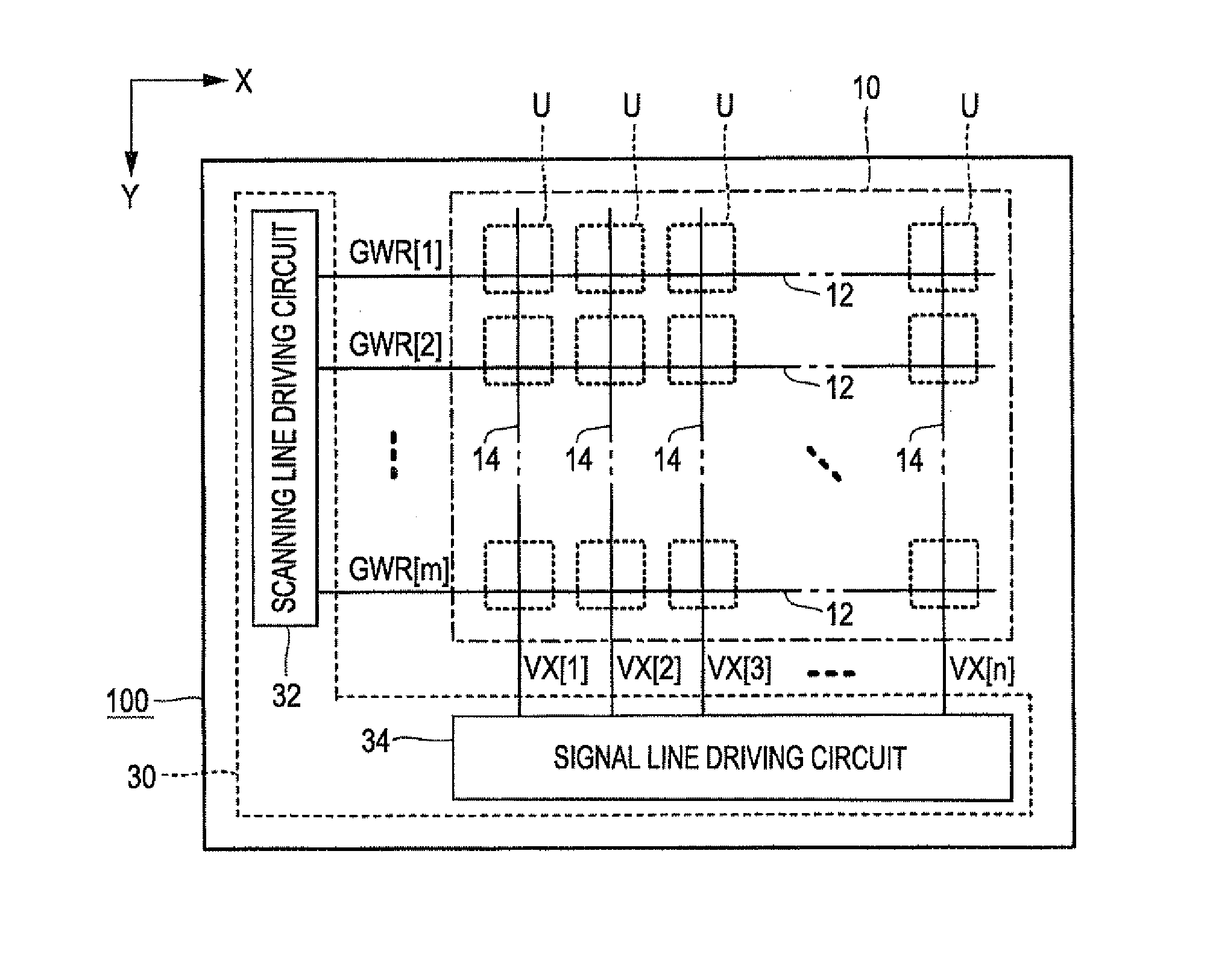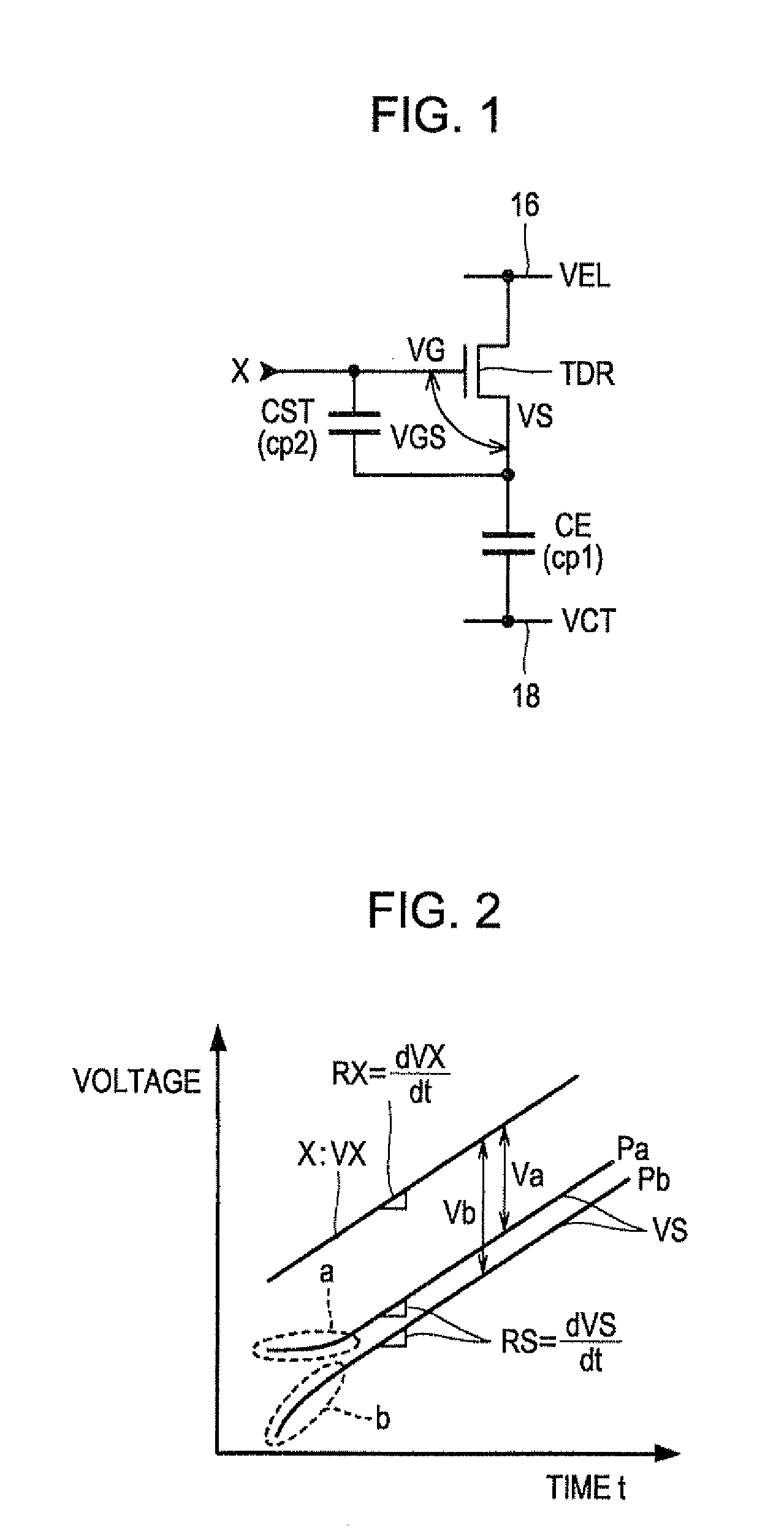Light Emitting Device, Electronic Device, and Method for Driving Pixel Circuit
- Summary
- Abstract
- Description
- Claims
- Application Information
AI Technical Summary
Benefits of technology
Problems solved by technology
Method used
Image
Examples
Example
First Modified Example
[0101]In the aforementioned embodiment, each of the data signals (data potentials VX) has the so-called ramp waveform, and the potential of each data signal is monotonically increased. When the specified gradation is high, the gradient of the potential of the data signal is steep. When the specified gradation is low, the gradient of the potential of the data signal is gentle. The selecting transistor TS is turned off during the time period when the potential of the data signal is monotonically increased. When a gradation for which the potential of the data signal is constant is specified, or when a gradation (low gradation) for which a change in the potential of the selected signal (scanning signal SWR) is approximately constant is specified, the selecting transistor TS does not need to be turned off during the period time when the potential of the data signal is monotonically increased.
Example
Second Modified Example
[0102]In the aforementioned embodiment, the potential of the scanning signal GWR[i] is set to the selection potential VSL at the start time is of the i-th writing period PWRT ((unit time period H[i]) that is included in the vertical scanning time period) and is linearly reduced over time at a constant rate for the i-th writing period PWRT (from the start time ts to the end time te). The change in the potential of the scanning signal GWR[i] is not limited to the aforementioned embodiment and may be arbitrary. In short, the potential of the scanning signal GWR[i] may be arbitrarily changed as long as the potential of the scanning signal GWR[i] changes over time for the writing period PWRT from the start time ts (when the potential of the scanning signal GWR[i] is set to the selection potential VSL) to the end time te.
[0103]In FIG. 11, when the maximum gradation Dmax is specified, the potential of the scanning signal may be arbitrarily set as long as the selectin...
Example
Fourth Modified Example
[0107]The conductivity type of each of the transistors (driving transistors TDR, selecting transistors TS, light emission control transistors TGEL, first switching elements SW1 and second switching elements SW2) is arbitrary. For example, the driving transistors TDR may be P-channel transistors. When the P-channel driving transistors TDR are used, the levels (high or low levels) of the voltages are reversed compared with the case in which the N-channel driving transistors TDR are used. However, operations of each P-channel driving transistor TDR are essentially the same as the operations of each N-channel driving transistor TDR described in the aforementioned embodiment and are not described in detail.
Fifth Embodiment
[0108]In the aforementioned embodiment, the amount of the driving current IDR that is to be supplied to the light emitting element E is determined on the basis of the rate RX of change of the data potential VX over time at the end time te of the w...
PUM
 Login to View More
Login to View More Abstract
Description
Claims
Application Information
 Login to View More
Login to View More - R&D
- Intellectual Property
- Life Sciences
- Materials
- Tech Scout
- Unparalleled Data Quality
- Higher Quality Content
- 60% Fewer Hallucinations
Browse by: Latest US Patents, China's latest patents, Technical Efficacy Thesaurus, Application Domain, Technology Topic, Popular Technical Reports.
© 2025 PatSnap. All rights reserved.Legal|Privacy policy|Modern Slavery Act Transparency Statement|Sitemap|About US| Contact US: help@patsnap.com



